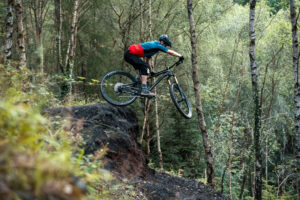Why mountain biking is a triathletes secret weapon
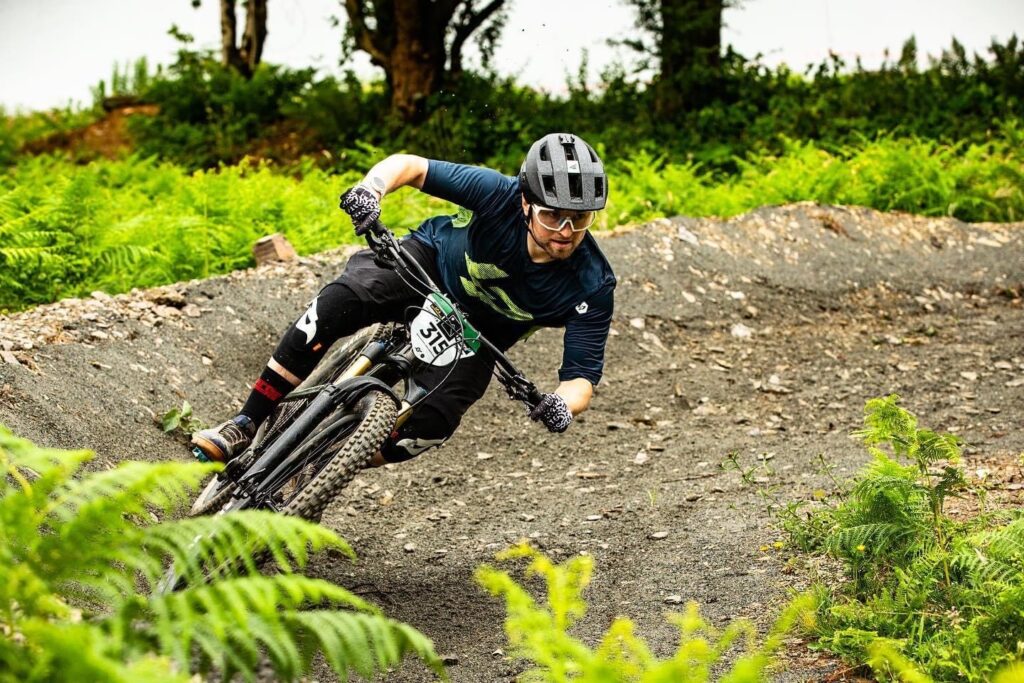
In this weeks edition of the Draft, BTF x YJ age group ambassador, Lewis Bradley gives his advice for triathletes who are looking to get faster. Thank You Lewis!
….
Speed is everything in triathlon, all three disciplines are defined by the speed of the athlete which results in the best overall time. Many triathletes use the bike leg to chase time lost in the swim (like myself) and try to push huge amounts of power to make sure they can be in with a chance of a great overall time and finishing position.
During the winter, many triathletes chase ‘aero gains’ by purchasing new components and accessories while indoor training to maximize their progression ready for the new season. But what people fail to train is their skills, all the money spent on bike fits, new components and indoor training can be wasted by not improving your bike handling skills and drills.
The UK and some parts of Europe don’t have the luxury of flat, smooth and open roads where you can easily hold yourself in a powerful TT position and know you are relatively safe. Lots of triathlon races include fast descents with winding bends and obstacles that can really affect your performance and overall time.
For example, you can lose more time on the descents than gain time on the hills of the famous Ironman Wales Course if you are not confident in your abilities. All that valuable energy pushing on the climbs will be wasted when your competitor steamrolls past you confidently and relaxed on the descent.
By incorporating mountain biking or gavel into your training, you can quickly gain tremendous amounts of skill and confidence that can take you to the next level in the bike leg of a triathlon.
Here’s some of the areas that you can save yourself valuable time by incorporating mountain biking into your training for better triathlon results:
Probably the most common trait of a triathlete carrying too much power into the corner and braking too late, resulting in ‘panic breaking’ in the middle of the turn. This results in the rider losing all the ‘free-speed’ built up to carry them around the turn. The rider will then have to put tremendous amounts of power through their pedals after the turn is completed to build-back the speed they once had.
When mountain biking, you learn to carry your speed though the turn which then propels you forward with more speed into the next corner or straight. By braking before the turn, it allows you to look ahead and have more confidence to carry more speed through the corner as the rider is not panicking about the possibility of what could happen.
Top Tip: When arriving at an a turn, always use the phrase ‘Slow in, fast out’
Another area where triathletes lose speed is by not scanning the road ahead of them.
Looking at your front wheel (Or just in-front) does not allow your brain to process information quick enough to react to obstacles or changes in the road layout, this a common mistake by athletes in their TT bars due to the lack of vision and athletes in general when coming to the end of the bike leg of a triathlon.
By incorporating gravel or mountain biking into training, this valuable skill will become a normality when racing on the road. When riding through woodlands where the trail may be obstructed by trees, the rider is forced to look ahead to stay on-track and to keep speed. By looking at the floor, the rider will not be aware of the turns, drops, hills or any other obstacle that may be ahead of them.
Photo credit: Dave Price Photography
If we put this scenario into a road perspective, looking ahead will allow you to become more aware of potholes, sharp turns and just general riding. If the triathlon race is on closed roads, this will make even more of a difference because you can really attack the road ahead of you and confidently react to obstacles ahead quicker due to having more visibility further up the road.
Top Tip: You wouldn’t look at the end of your car bonnet so why look at your front wheel when cycling?
This skill comes with time and can really elevate your opportunity when it comes to triathlon racing, but training for this skill can be completed more efficiently on a mountain bike.
Line choice is important when cornering in triathlon and is feared by many due to the risk involved, hence why many like to enter races where it’s as straight and flat as possible. On the other hand, many like the challenge of a hilly bike route but forget that what goes up must come down.
Even if you don’t know the route, having confidence to position your bike on the road before turns can significantly allow you to have more speed and a better overall bike time in a triathlon. When you hug the inside of a turn, you run the risk of your bike sliding out beneath you or running out of road. When starting in the middle of the road and then hitting the apex of the turn (Apex being the point of minimum radius and slowest speed achieved in a corner) you allow the bikes to carry more speed through the turn with less effort. By not achieving this skill, you are significantly slowing yourself down and using more energy to correct yourself.
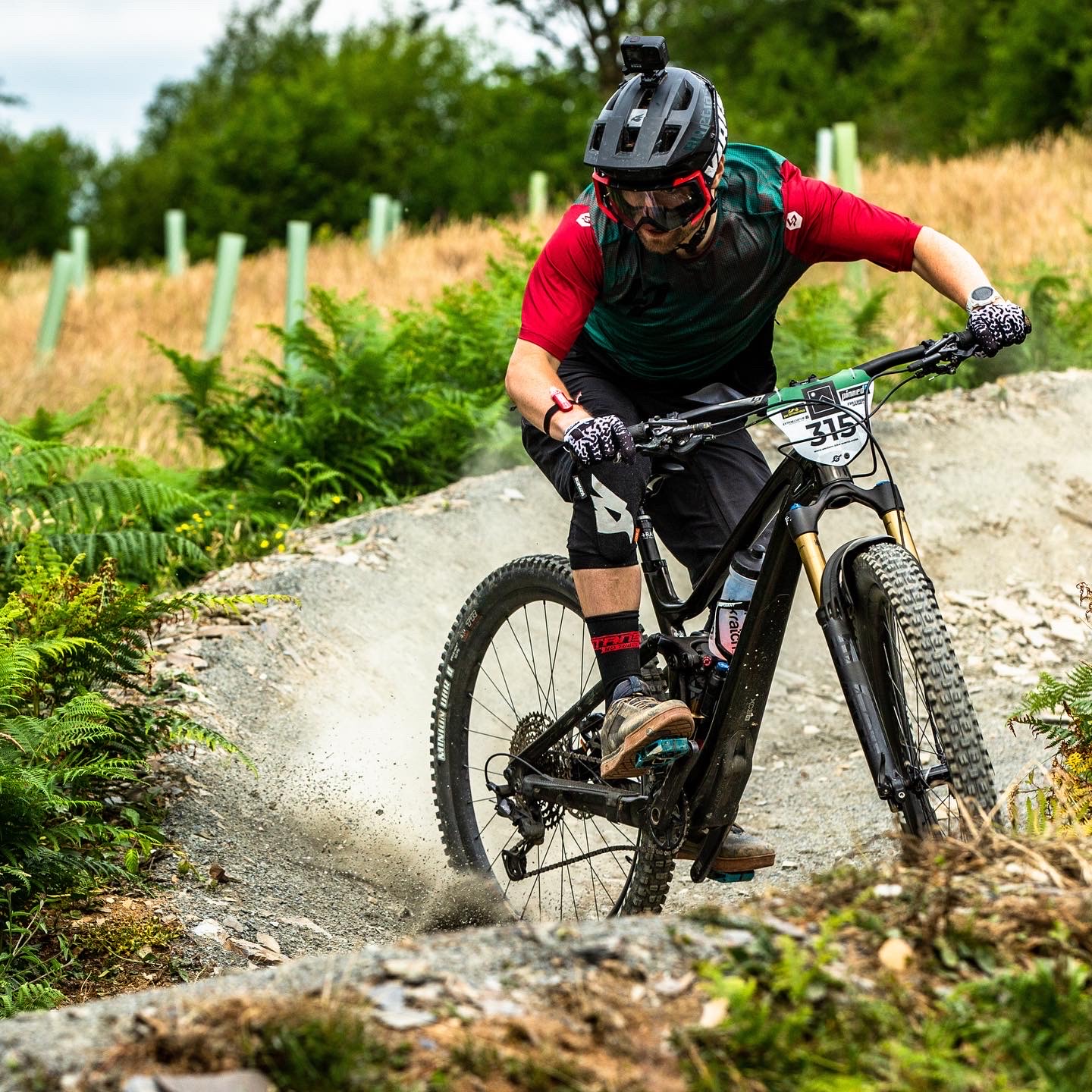 Photo credit: Dave Price Photography
Photo credit: Dave Price Photography
Watching formula 1 or any kind of circuit racing will also put this into perspective, they use the whole of the road and hit the apex of the turn to maximize speed and efficiency of the car.
Mountain biking will allow you to safely learn this skill and will also allow you to help judge the speed that you can go into turns. Each turn will never be the same as another so learning the degree of turns and apex’s can open up new opportunities in a closed road triathlon or a draft-legal tri where you are trying to break from the pack.
Top Tip: In an MTB skills park or trail, find a set of turns that you can practice repeatedly until you feel confident, then add extra parts of the trail before and after to build speed and find the best line choice. Try with a mate to make it more competitive!
There’s nothing worse than overtaking your competitors on a hill, for them to suddenly fly past you on the descents.
Occurring when tired or scared of descending at speed, many triathletes will feather or pull the brakes while traveling downhill. Not only does that add strain to your brain, body and bike. But also eats into your speed and the effort you just put into climbing the hills that you have completed.
There’s no real training that will make a difference immediately, it will come by experience and knowledge while training. The overall aim is to make your brain relax.
By allowing your brain to relax, you will allow your hands to stop constantly pressing the brakes and allow for more free speed! This is best trained on a mountain bike as there will be less to think about compared to the road. In addition, you will start to learn your boundaries and the risk that is involved which can allow you to make better decisions while descending,
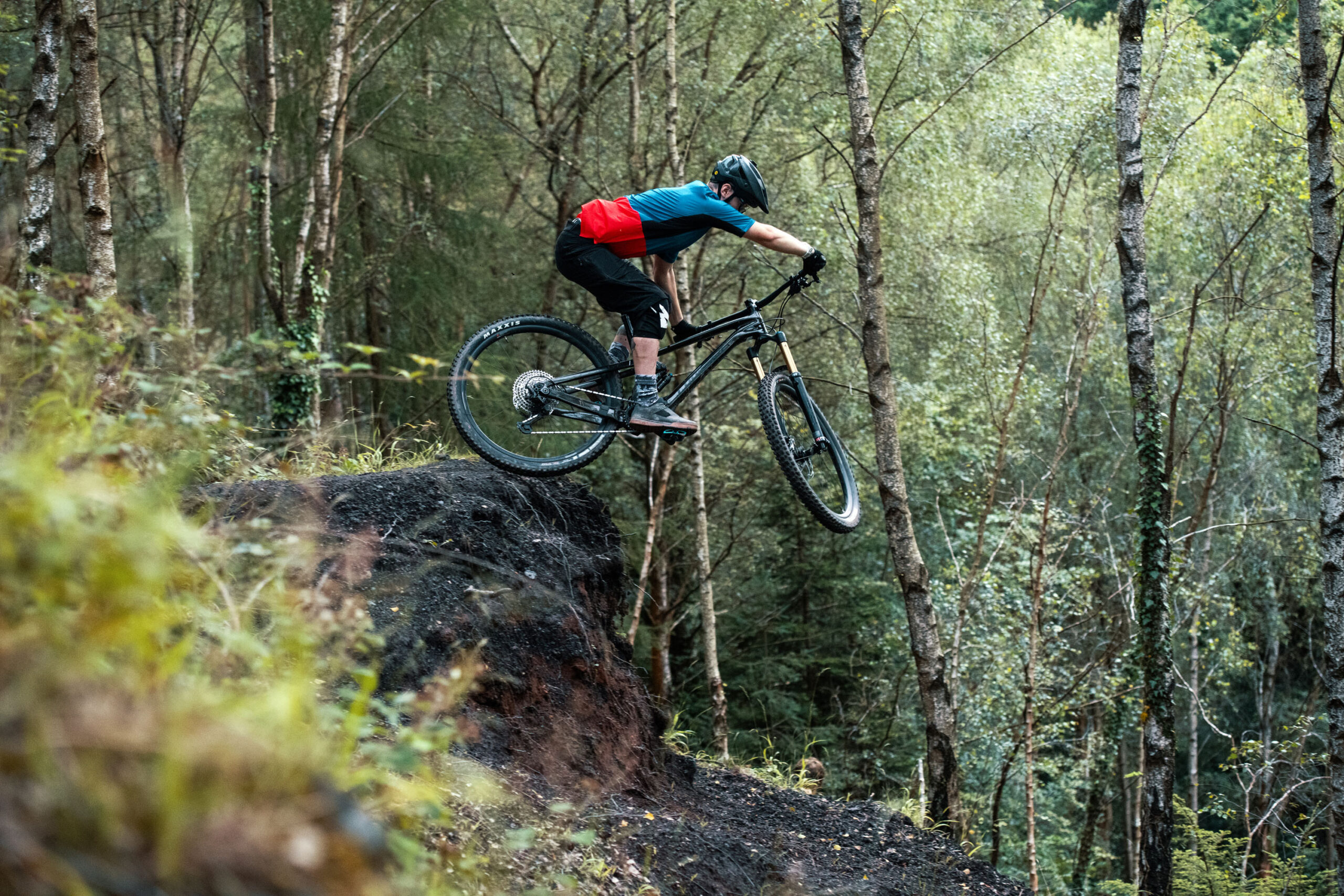
Top Tip: When maintaining your bike skills while mountain biking, try to add some descending at speed into your ride. Find a long and wide fireroad / gravel road that you can gradually get faster on. Over time you can link turns and trails into this that can really push your boundaries to make you a better cyclist!
Lastly, the most complex of them all. When you have nailed the four points above you will automatically start to achieve the next point which is leaning the bike into the turns.
Although you may only have 23-28mm tyres, this is more than enough for a contact point to be made to the tarmac below you. By knowing the machinery beneath you and the new found confidence you have by mountain biking, you will be able to understand how important it is to lean the bike into the turn instead of letting the handlebars do the turning for you.
Question?
When turning at moderate or fast speeds, how far do your handlebars turn?
The Answer
Not much at all!
Why is this? Think of a Motorcycle on a track. The eyes of the rider looking ahead, lean of the shoulder and trailing of the knee is leading the handlebar to slightly turn in the direction of where the rider wants it to go. When cyclists allow the handlebar to dictate the corner it leads to disaster due to the front end being ‘jackknifed’. This is normally seen when there are sharp 90 degree turns or roundabouts where people haven’t nailed all the points above.
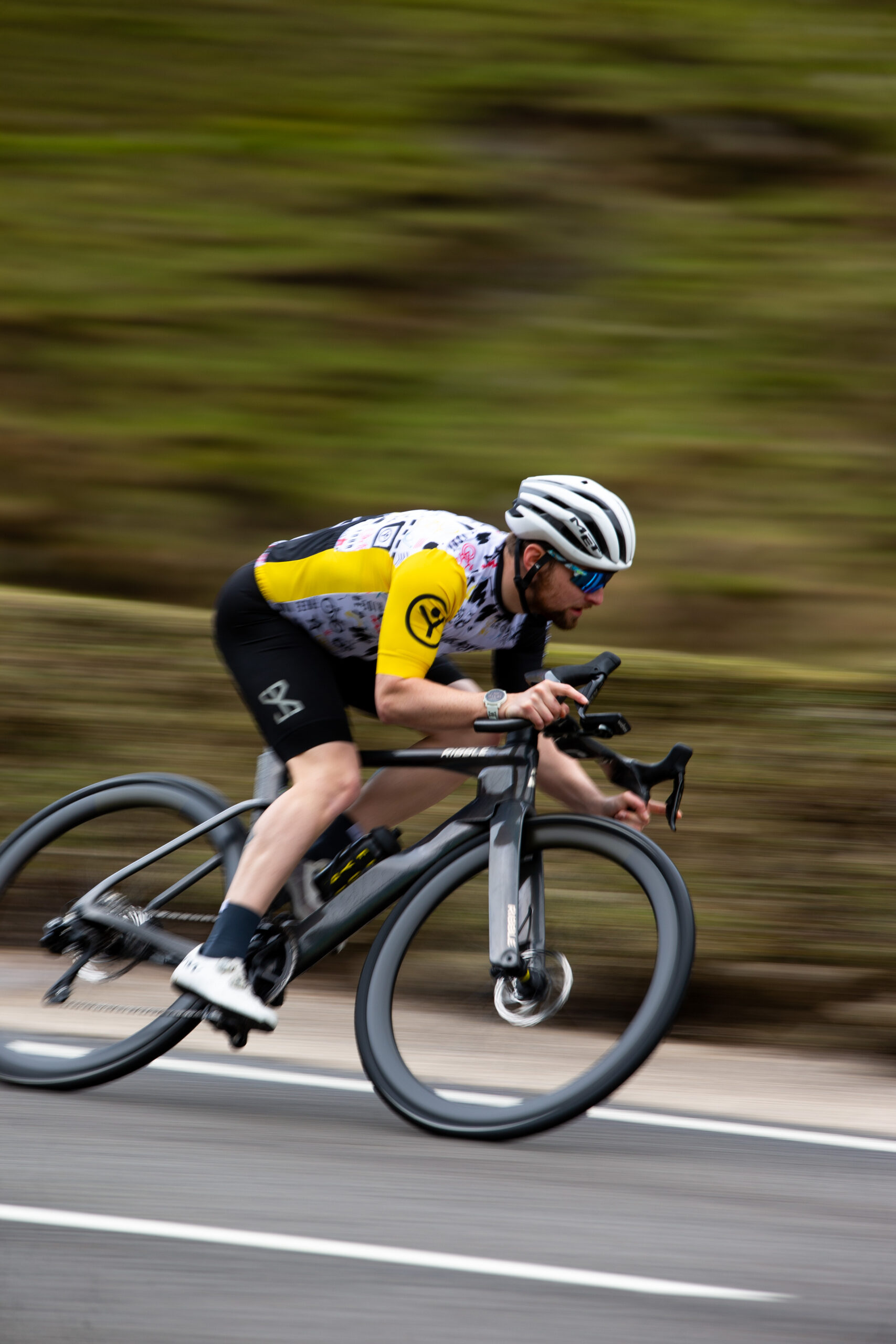 Photo credit: Dave Price Photography
Photo credit: Dave Price Photography
There are many skill parks for mountain bikers to work on their technique and cycling ability, which includes a variety of turns that includes ‘berms’. Berms are bank turns that allow the rider to lean the bike beneath them, transferring this technique to the road would allow you to really push the boundaries and opportunities, in addition to exploiting weaknesses in your competitors and reducing your overall time from the bike course.
Top Tip: Find ‘berms’ at a local mountain bike skills park to help work on leaning the bike over with your eyes, inside shoulder and inside knee to really help with carrying speed through a variety of corners.
Personally, I get very excited and thrive on a technical triathlon course due to the opportunity it presents. Not being afraid to carry speed into corners and chase the riders in front of me really pushes me to try harder. Even when the course is a flat ‘crit’ course through a city (Like Cardiff Triathlon), I know I have the skills to not touch the brakes into 90 degree turns and roundabouts.
When I completed cardiff Triathlon 70.3 a few years back (My first 70.3 ever), I came out of the water 49th overall, and after the 57 miles of the twisty and technical bike course was completed I was sitting 8th overall (with the 3rd fastest bike split of the day), not bad for a modified road bike!
Enough about me. Progression comes with time and dedication, one ride on a mountain bike isn’t going to make you a ‘hero’ so I suggest taking your time when adding mountain biking into your training plan, winter is the perfect time to do this and can also help motivate you to get out during the grim weather. Find a local trail centre with ‘official’ route maps and trail grading so you can work your way up.
In addition, you don’t need an expensive bike, all mountain bikes should be able to handle green and blue graded trails which can then help you work on the 5 key areas highlighted above. And like road rides, go as a group so you can learn from each other and listen to feedback given from others, many mountain bikers like to help so listen to their honest feedback because they will make you a better rider.
All of this comes back to the first paragraph of the article, all of the areas covered above result in more speed without even spending a penny of your road or triathlon bike. All five areas result in ‘Free-speed’ that you can use for any race course and should allow you to have much more confidence when racing in the future. So next time you think about bike training, why not dig that mountain bike out of the shed and give it some love!
Give Lewis a follow on Instagram here!


